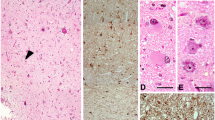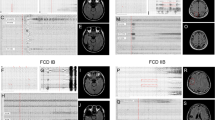Abstract
Objects
Balloon cells are histopathological hallmarks of cortical malformations, i.e., focal cortical dysplasia (FCD) of the Taylor type or the cortical tubers of tuberous sclerosis, and they are believed to be the epileptogenic substrate and cause therapeutic drug resistant epilepsy in man. This study was carried out to investigate the developmental histogenesis and epileptogenesis of balloon cells in FCD.
Materials and methods
We used an immunohistochemical approach to examine the expressions of primitive neuroepithelial cell antigens (CD34, nestin, and vimentin), ionotrophic glutamate receptor subunits (NR1, NR2A/B, GluR1, GluR2, GluR3, GluR4, and GluR5/6/7), and P-glycoprotein in balloon cells from FCD and normal cerebral cortex epileptogenic lesions.
Conclusion
Balloon cells presented in clusters or as scattered cells throughout FCD lesions involving the gray and white matter. We found the balloon cells to be classifiable into three subtypes based on glial fibrillary acidic protein (GFAP) and neurofilament protein (NF-L) immunohistochemistry, i.e., as neuronal, astrocytic, and uncommitted. Immunopositivity for nestin, CD34, and vimentin in balloon cells of FCD suggests that they may be derived from the abnormal development and differentiation of neural stem cells. Moreover, it appears that epileptogenesis in cortical dysplasia is partly caused by the upregulations of some glutamate receptor subunit proteins (NR1, NR2A/B, GluR1, and GluR3) in balloon cells and dysplastic neurons. We speculate that the presence of the drug resistance protein P-glycoprotein in balloon cells might explain medically refractory epilepsy in FCD.



Similar content being viewed by others
References
Arai N, Oda M (1997) Surgical neuropathology of intractable epilepsy. Epilepsia 38:11–16
Armstrong DD, Bruton CJ (1987) Postscript: what terminology is appropriate for tissue pathology? How dose it predict outcome? In: Emgel J Jr Surgical treatment of the epilepsies 2nd edn. NewYork, Raven, pp 49–63
Aronica E, Gorter JA, Jansen GH, van Veelen CW, van Rijen PC, Leenstra S, Ramkema M, Scheffer GL, Scheper RJ, Troost D (2003) Expression and cellular distribution of multidrug transporter proteins in two major causes of medically intractable epilepsy: focal cortical dysplasia and glioneuronal tumors. Neuroscience 118:417–429
Barkovich AJ, Kjos BO (1992) Gray matter heterotopias: MR characteristics and correlation with developmental and neurologic manifestations. Radiology 182:493–499
Barkovich AJ, Kuzniecky RI, Dobyns WB, Jackson GD, Becker LE, Evard P (1996) A classification scheme for malformations of cortical development. Neuropediatrics 27:59–63
Barkovich AJ, Raybaud CA (2004) Neuroimaging in disorders of cortical development. Neuroimaging Clin N Am 14:231–254
Barth PG (1987) Disorders of neuronal migration. Can J Neurol Sci 14:1–16
Blumcke I, Wiestler OD (2002) Gangliogliomas: an intriguing tumor entity associated with focal epilepsies. J Neuropathol Exp Neurol 61:575–584
Farrel MA, DeRosa MJ, Curran JG, Secor DL, Cornford ME, Comair YG, Peacock WJ, Shields WD, Vinters HV (1992) Neuropathologic findings in cortical resections (including hemispherectomies) performed for the treatment of intractable childhood epilepsy. Acta Neuropathol Berl 83:246–259
Fina L, Molgaard HV, Robertson D, Bradley NJ, Monaghan P, Delia D, Sutherland DR, Baker MA, Greaves MF (1990) Expression of the CD34 gene in vascular endothelial cells. Blood 15(75):2417–2426
Hollmann M, Heinemann S (1994) Cloned glutamate receptors. Annu Rev Neurosci 17:31–108
Kalman M, Ajtai BM (2001) A comparison of intermediate filament markers for presumptive astroglia in the developing rat neocortex: immunostaining against nestin reveals more detail, than GFAP or vimentin. Int J Dev Neurosci 19:101–108
Kilty IC, Barraclough R, Schmidt G, Rudland PS (1999) Isolation of a potential neural stem cell line from the internal capsule of an adult transgenic rat brain. J Neurochem 73:1859–1870
Krause DS, Fackler MJ, Civin CI, May WS (1996) CD34: structure, biology, and clinical utility. Blood 87:1–13
Kuzniecky RI, Barkovich AJ (1996) Pathogenesis and pathology of focal malformations of cortical development and epilepsy. J Clin Neurophysiol 13:468–480
Kuzniecky RI, Knowlton RC (2002) Neuroimaging of epilepsy. Semin Neurol 22:279–288
Lanza F, Healy L, Sutherland DR (2001) Structural and functional features of the CD34 antigen: an update. J Biol Regul Homeost Agents 15:1–13
Lazarowski A, Sevlever G, Taratuto A, Massaro M, Rabinowicz A (1999) Tuberous sclerosis associated with MDR1 gene expression and drug-resistant epilepsy. Pediatr Neurol 21:731–734
Lee MC, Kim KM, Woo YJ, Kim MK, Kim JH, Nam SC, Suh JJ, Chung WK, Lee JS, Kim HI, Choi HY, Kim SU (2001) Pathogenic significance of neuronal migration disorders in temporal lobe epilepsy. Human Pathol 32:643–648
Lee MC, Lee JS, Lee MJ, Lee JH, Kim HI (2001) Fas mediates apoptosis in steroid-induced myopathy of rats. Neuropathol Appl Neurobiol 27:396–402
Lendahl U, Zimmerman LB, McKay RD (1990) CNS stem cells express a new class of intermediate filament protein. Cell 23(60):585–595
Lin G, Finger E, Gutierrez-Ramos JC (1995) Expression of CD34 in endothelial cells, hematopoietic progenitors and nervous cells in fetal and adult mouse tissues. Eur J Immunol 25:1508–1516
Lukas Z, Draber P, Bucek J, Draberova E, Viklicky V, Staskova Z (1989) Expression of vimentin and glial fibrillary acidic protein in human developing spinal cord. Histochem J 21:693–701
Meencke HJ, Janz D (1984) Neuropathological findings in primary generalized epilepsy: a study of eight cases. Epilepsia 25:8–21
Meguro H, Mori H, Araki K, Kushiya E, Kutsuwada T, Yamazaki M, Kumanishi T, Arakawa M, Sakimura K, Mishina M (1992) Functional characterization of a heteromeric NMDA receptor channel expressed from cloned cDNAs. Nature 357:70–74
Meldrum BS, Akbar MT, Chapman AG (1999) Glutamate receptors and transporters in genetic and acquired models of epilepsy. Epilepsy Res 36:189–204
Mischel PS, Nguyen LP, Vinters HV (1995) Cerebral cortical dysplasia associated with pediatric epilepsy: Review of neuropathologic features and proposal for grading system. J Neuropathol Exp Neurol 54:137–153
Mizoguchi M, Iwaki T, Morioka T, Fukui M, Tateishi J (1998) Abnormal cytoarchitecture of cortical dysplasia verified by immunohistochemistry. Clin Neuropathol 17:100–109
Monyer H, Sprengel R, Schoepfer R, Herb A, Higuchi M, Lomeli H, Burnashev N, Sakmann B, Seeburg PH (1992) Heteromeric NMDA receptors: molecular and functional distinction of subtypes. Science 256:1217–1221
Nakanishi S, Masu M (1994) Molecular diversity and functions of glutamate receptors. Ann Rev Biophy Biomol Struct 23:319–348
Natkunam Y, Rouse RV, Zhu S, Fisher C, van De Rijn M (2000) Immunoblot analysis of CD34 expression in histologically diverse neoplasms. Am J Pathol 156:21–27
Pasquier B, Peoc’ h M, Fabre-Bocquentin B, Bensaadi L, Pasquier D, Hoffmann D, Kahane P, Tassi L, Le Bas JF, Benabid AL (2002) Surgical pathology of drug-resistant partial epilepsy. A 10-year-experience with a series of 327 consecutive resections. Epileptic Disord 4:99–119
Plate KH, Wieser HG, Yasargil MG, Wiestler OD (1993) Neuropathological findings in 224 patients with temporal lobe epilepsy. Acta Neuropathol Berl 86:433–438
Ploemacher RE (1999) Characterization and biology of normal human haematopoietic stem cells. Haematologica 84(Suppl EHA 4):4–7
Prayson RA, Frater JL (2003) Cortical dysplasia in extratemporal lobe intractable epilepsy: a study of 52 cases. Ann Diagn Pathol 7:139–146
Raymond AA, Fish DR, Sisodiya SM, Alsanjari N, Stevens JM, Shorvon SD (1995) Abnormalities of gyration, heterotopias, tuberous sclerosis, focal cortical dysplasia, microdysgenesis, dysembryoplastic neuroepithelial tumour and dysgenesis of the archicortex in epilepsy. Clinical, EEG, and neuroimaging features in 100 adult patients. Brain 118:629–660
Reifenberger G, Weber T, Weber RG, Wolter M, Brandis A, Kuchelmeister K, Pilz P, Reusche E, Lichter P, Wiestler OD (1999) Chordoid glioma of the third ventricle: immunohistochemical and molecular genetic characterization of a novel tumor entity. Brain Pathol 9:617–626
Reifenberger G, Kaulich K, Wiestler OD, Blumcke I (2003) Expression of the CD34 antigen in pleomorphic xanthoastrocytomas. Acta Neuropathol (Berl) 105:358–364
Rizz M, Caccia S, Guiso G, Richichi C, Gorter JA, Aronica E, Alipran DM, Bagnati R, Fanelli R, D'incalci M, Samanin R, Vezzani A (2002) Limbic seizures induce P-glycoprotein in rodent brain: functional implications for pharmacoresistence. J Neurosci 22:5883–5839
Schinkel AH, Wagenaar E, Mol CA, Van Deemter L (1996) P-glycoprotein in the blood-brain barrier of mice influences the brain penetration and pharmacological activity of many drugs. J Clin Invest 97:2517–2524
Sisodiya SM, Heffernan J, Squier MV (1999) Overexpression of P-glycoprotein in malformations of cortical development. Neuroreport 10:3437–3441
Sisodiya SM, Lin WR, Harding BN, Squier MV, Thom M (2002) Drug resistance in epilepsy: expression of drug resistance proteins in common causes of refractory epilepsy. Brain 125:22–31
Steen R, Egeland T (1998) CD34 molecule epitope distribution on cells of haematopoietic origin. Leuk Lymphoma 30:23–30
Steward VW, Jevtic MM (1979) Derangement of neuronal migration in a child with multiple congenital anomalies, two congenital neoplasms, without apparent chromosomal abnormalities. J Neuropathol Exp Neurol 38:259–285
Sutherland DR, Keating A (1992) The CD34 antigen: structure, biology, and potential clinical applications. J Hematother 1:115–129
Taylor DC, Falconer MA, Bruton CJ, Corsellis JAN (1971) Focal dysplasia of the cerebral cortex in epilepsy. J Neurol Neurosurg Psychiat 34:369–387
Wong RK, Bianchi R, Taylor GW, Merlin LR (1999) Role of metabotropic glutamate receptors in epilepsy. Adv Neurol 79:685–698
Wood HB, May G, Healy L, Enver T, Morriss-Kay GM (1997) CD34 expression patterns during early mouse development are related to modes of blood vessel formation and reveal additional sites of hematopoiesis. Blood 15:2300–2311
Yabe JT, Chan WK, Wang FS, Pimenta A, Ortiz DD, Shea TB (2003) Regulation of the transition from vimentin to neurofilaments during neuronal differentiation. Cell Motil Cytoskeleton 56:193–205
Zhong Y, Thomas LB, Youssef GC, William B, Michael B, Kathy T (1998) Induced expression of NMDAR2 proteins and differential expression of NMDAR1 splice variants in dysplastic neurons of human epileptic neocortex. J Neuropathol Exp Neurol 57:47–62
Acknowledgment
This study was financially supported by the Brain Disease Research Center of KOSEF in Ajou University, Suwon, Korea.
Author information
Authors and Affiliations
Corresponding author
Rights and permissions
About this article
Cite this article
Oh, HS., Lee, MC., Kim, HS. et al. Pathophysiologic characteristics of balloon cells in cortical dysplasia. Childs Nerv Syst 24, 175–183 (2008). https://doi.org/10.1007/s00381-007-0453-z
Received:
Published:
Issue Date:
DOI: https://doi.org/10.1007/s00381-007-0453-z




